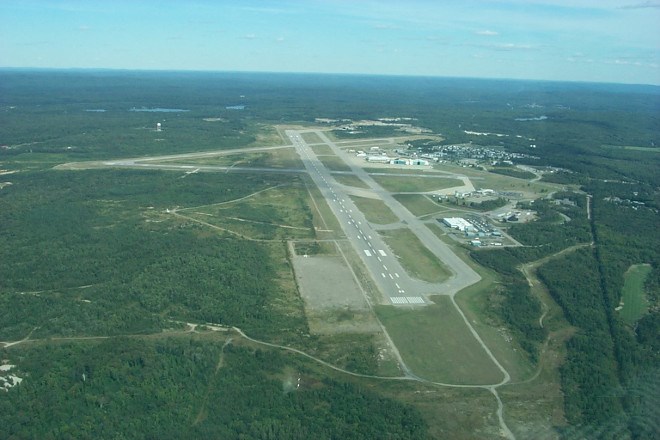The secondary runway at Jack Garland Airport in North Bay has received a $5-million upgrade.
At 5,000 feet, the crosswind runway is half the size of the facility’s 10,000-foot main runway, but it had deteriorated to a point that renovations could no longer be deferred.
“It has not received anything other than repair and overhaul for 30 years,” said Kelly Hewitt, the airport’s commercial development manager. “So it was at the point where something needed to be done or we were going to have to look at limiting its operation.”
Pilots use a crosswind runway when winds are high and using the main runway would jeopardize a safe landing. Smaller aircraft are particularly impacted by crosswinds.
In North Bay, renovations consisted of removing all the asphalt from the crosswind runway and performing some maintenance work on the substrate, Hewitt said.
Since many of the industry regulations have changed over the last three decades, the runway had to be brought up to contemporary standards, he noted.
That included lighting and the landscaping of the runway end safety areas, or RESAS, areas surrounding the runway serving as a sort of safety net that helps reduce potential damage to a plane that overshoots the runway.
“These areas had to be graded, and they had to have a proper type of gravel, so that if you did, under unfortunate circumstances, go off the end of the runway, the type of runout that was there now had to be engineered, whereas before it was just a field,” Hewitt said.
Want to read more stories about business in the North? Subscribe to our newsletter.
Though initial estimates put the work at just over $3 million, Hewitt said the airport opted to pay a little more to upgrade the electrical system for the runway lights, installing new wiring and, in some cases, switching over to more efficient LED lights.
It made sense to do the work while the runway was already being dug up, he noted, rather than revisit the project at a future date.
“It was a larger project, but we still cost-contained and put it together so that we weren't actually doing repairs to our repair in just a few years down the road,” he said.
Work began in June and wrapped up on Aug. 23, about a month past the original July deadline.
Inclement weather and scheduling conflicts with electricians and painters prolonged the project, Hewitt said. But no flights had to be turned away, and now both runways are back to running smoothly.
The final price tag worked out to about $1 million per 1,000 feet of runway.
A portion of that – $2.4 million – was covered by the Northern Ontario Heritage Fund Corp. (NOHFC). The funding was announced on Sept. 13 after the renovations were already completed.
“Our government is committed to supporting Northern communities, making them attractive places to both live and work," Nipissing MPP Vic Fedeli said in a release announcing the funds.
"This project provides the critical infrastructure needed to retain and attract new business to North Bay, sending a signal to the world that Northern Ontario is open for business."
That seems to be the case for Jack Garland Airport, whose industrial park is nearing capacity.
Hewitt said the second-last lot is currently going through the approvals and planning process, which will leave just one lot left in the park, which was developed in 2012.
But there remains lots of land available to the north of the airport, where Hewitt said the city may next shift its focus.
“Development will be based on need and interest,” he said. “They’re now saying there’s a need and there continues to be interest.”
Because of the astronomical cost of warehousing in Toronto, more businesses are looking at North Bay as an affordable alternative, he noted.
Companies based in North Bay have easy access to markets in both Northern Ontario and southern Ontario; Mississauga is only about three hours away by truck.
“Companies are asking, do they really need to be in Toronto?” Hewitt said. “If they’re moving things up and down Highway 17, it may make better sense to be in North Bay.”
A recent survey revealed that the airport indirectly employs 400 people and has a direct economic impact in the community of $57 million.
The survey also showed that Jack Garland welcomes 80,000 passengers and 400,000 movements every year, which Hewitt said is part of an upward trend. But, since passengers are usually accompanied by friends and family, the number of people passing through the airport every year may actually be closer to 200,000 he noted.
Since last December, some of those visitors have been coming to the airport just for the unique food being served at the North Himalayan Café, which opened its doors just before Christmas.
Traditional Nepalese food, served by entrepreneurs Sujala Niroula and Laxmi Konwar, has been a hit with travellers, local students and residents alike.
“We’ve adjusted some of our parking privileges in the evening,” Hewitt said. “And they’ve actually adjusted their hours because they’re getting more and more people specifically just for the food.”
The unique airport cuisine even garnered an honourable mention this summer after being nominated as one of the best restaurants in Canada by the Canadian Owners and Pilots Association (COPA), an organization that represents the country’s small aircraft owners.




